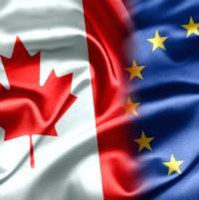(STRASBOURG) – The European Parliament gave its approval to the landmark EU-Canada free trade deal Wednesday, with the possibility that it could apply provisionally from as early as this April.
The Comprehensive Economic and Trade Agreement (CETA) will remove customs duties, end restrictions on access to public contracts, open-up the services market, offer predictable conditions for investors and help prevent illegal copying of EU innovations and traditional products.
In 2015 the EU imported goods from Canada worth 28.3 billion and exported goods to it worth 35.2 billion, a figure that is expected to rise by more than 20% when the agreement is implemented in full.
“By adopting CETA, we chose openness and growth and high standards over protectionism and stagnation”, said Artis Pabriks MEP, Parliament’s rapporteur for CETA: “Canada is a country with whom we share common values and an ally we can rely on. Together we can build bridges, instead of a wall, for the prosperity of our citizens. CETA will be a lighthouse for future trade deals all over the world,” he said.
Commission President Jean-Claude Juncker also welcomed the agreement, saying EU companies and citizens would be able to start reaping the benefits that the agreement offers as soon as possible.
He also said the “progressive agreement is an opportunity to shape globalisation together and influence the setting of global trade rules.”
CETA will remove tariffs on most traded goods and services. It also provides for the mutual recognition of certification for a wide range of products. Canada is to open up its federal and municipal public procurement markets, which are already open in Europe. EU suppliers of services ranging from sea shipping through telecoms and engineering to environmental services and accountancy will get access to the Canadian market.
Addressing concerns on protecting farm produce and social standards. the EU has secured protection for over 140 European geographical indications for food and drinks sold on the Canadian market. Sustainable development clauses were included to safeguard environmental and social standards and ensure that trade and investment enhance both.
To allay citizens concerns that the deal gives too much power to multinational companies and that governments will not be able to legislate to protect health, safety or the environment, the EU and Canada recognise in both the preamble to the deal and an attached joint declaration that its provisions apply without prejudice to the domestic right to regulate.
There are some exceptions. For instance, the CETA deal will not remove tariff barriers in the fields of public services, audiovisual and transport services and a few agricultural products, such as dairy, poultry and eggs.
On investment protection, the controversial investor-state-dispute settlement (ISDS) mechanism has been replaced by the Investment Court System (ICS), which aims to ensure government control over the choice of arbitrators and enhances transparency.
The CETA deal could apply provisionally on the first day of the second month following the date both sides have notified each other that they completed all necessary internal procedures. MEPs expect this to be the case on 1 April 2017 at the earliest.
As CETA was declared a ‘mixed agreement’ by the Commission in July 2016, the CETA agreement will also need to be ratified by national and regional parliaments.
Further information, European Parliament
Full text of the Comprehensive Economic and Trade Agreement (CETA)
CETA main elements



